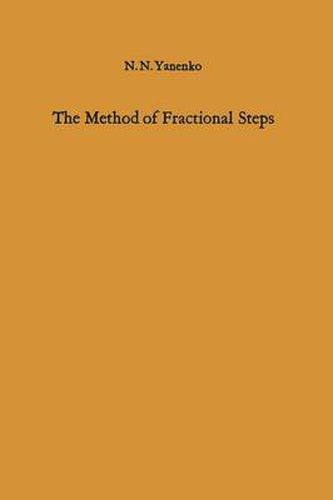Readings Newsletter
Become a Readings Member to make your shopping experience even easier.
Sign in or sign up for free!
You’re not far away from qualifying for FREE standard shipping within Australia
You’ve qualified for FREE standard shipping within Australia
The cart is loading…






This title is printed to order. This book may have been self-published. If so, we cannot guarantee the quality of the content. In the main most books will have gone through the editing process however some may not. We therefore suggest that you be aware of this before ordering this book. If in doubt check either the author or publisher’s details as we are unable to accept any returns unless they are faulty. Please contact us if you have any questions.
The method of. fractional steps, known familiarly as the method oi splitting, is a remarkable technique, developed by N. N. Yanenko and his collaborators, for solving problems in theoretical mechanics numerically. It is applicable especially to potential problems, problems of elasticity and problems of fluid dynamics. Most of the applications at the present time have been to incompressible flow with free bound aries and to viscous flow at low speeds. The method offers a powerful means of solving the Navier-Stokes equations and the results produced so far cover a range of Reynolds numbers far greater than that attained in earlier methods. Further development of the method should lead to complete numerical solutions of many of the boundary layer and wake problems which at present defy satisfactory treatment. As noted by the author very few applications of the method have yet been made to problems in solid mechanics and prospects for answers both in this field and other areas such as heat transfer are encouraging. As the method is perfected it is likely to supplant traditional relaxation methods and finite element methods, especially with the increase in capability of large scale computers. The literal translation was carried out by T. Cheron with financial support of the Northrop Corporation. The editing of the translation was undertaken in collaboration with N. N. Yanenko and it is a plea sure to acknowledge his patient help and advice in this project. The edited manuscript was typed, for the most part, by Mrs.
$9.00 standard shipping within Australia
FREE standard shipping within Australia for orders over $100.00
Express & International shipping calculated at checkout
This title is printed to order. This book may have been self-published. If so, we cannot guarantee the quality of the content. In the main most books will have gone through the editing process however some may not. We therefore suggest that you be aware of this before ordering this book. If in doubt check either the author or publisher’s details as we are unable to accept any returns unless they are faulty. Please contact us if you have any questions.
The method of. fractional steps, known familiarly as the method oi splitting, is a remarkable technique, developed by N. N. Yanenko and his collaborators, for solving problems in theoretical mechanics numerically. It is applicable especially to potential problems, problems of elasticity and problems of fluid dynamics. Most of the applications at the present time have been to incompressible flow with free bound aries and to viscous flow at low speeds. The method offers a powerful means of solving the Navier-Stokes equations and the results produced so far cover a range of Reynolds numbers far greater than that attained in earlier methods. Further development of the method should lead to complete numerical solutions of many of the boundary layer and wake problems which at present defy satisfactory treatment. As noted by the author very few applications of the method have yet been made to problems in solid mechanics and prospects for answers both in this field and other areas such as heat transfer are encouraging. As the method is perfected it is likely to supplant traditional relaxation methods and finite element methods, especially with the increase in capability of large scale computers. The literal translation was carried out by T. Cheron with financial support of the Northrop Corporation. The editing of the translation was undertaken in collaboration with N. N. Yanenko and it is a plea sure to acknowledge his patient help and advice in this project. The edited manuscript was typed, for the most part, by Mrs.